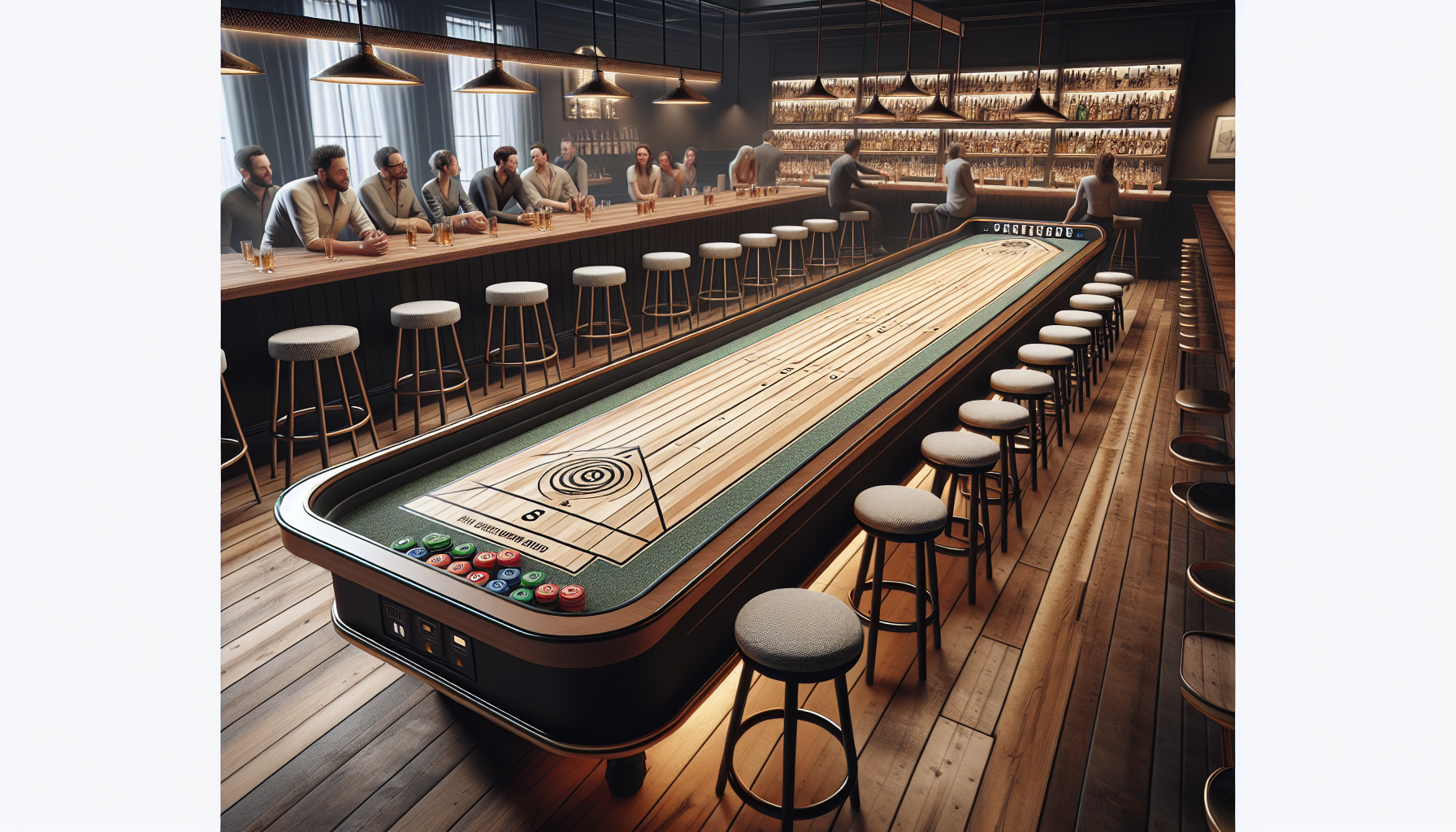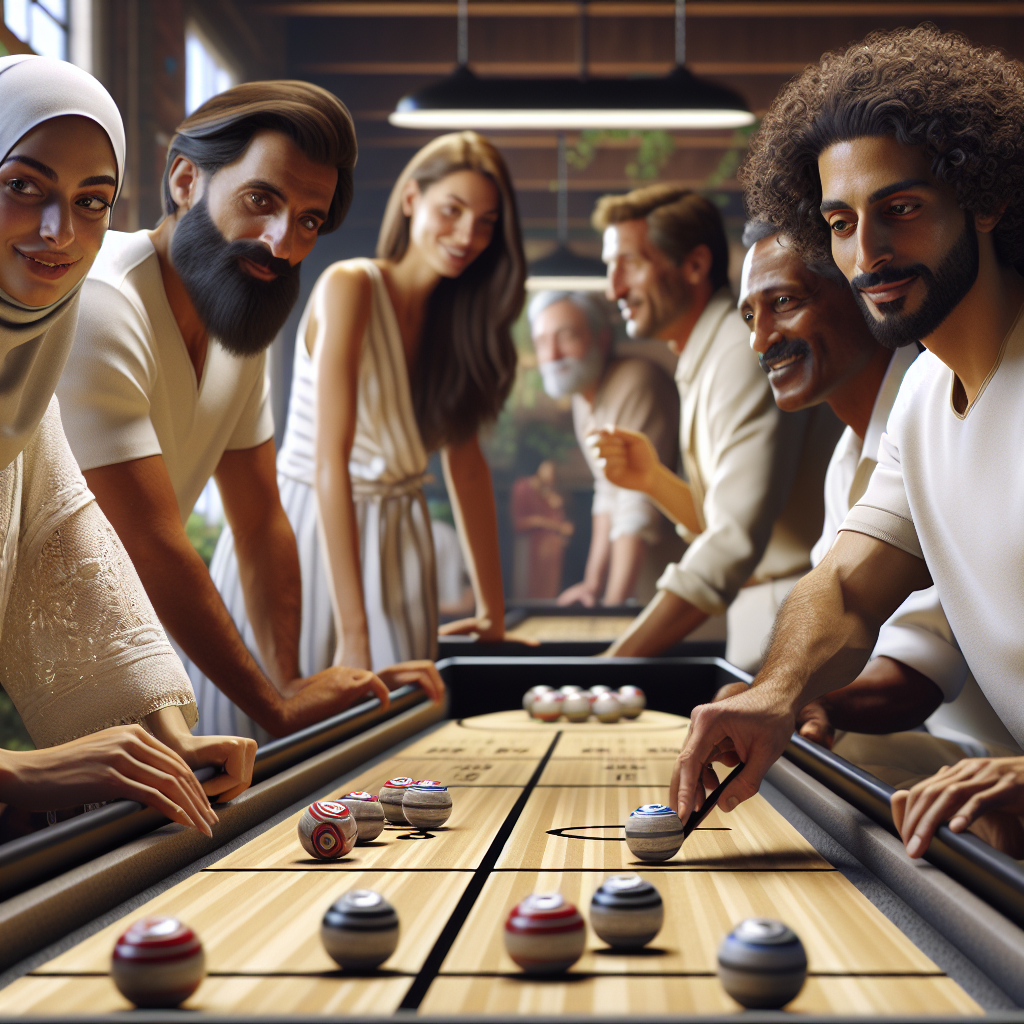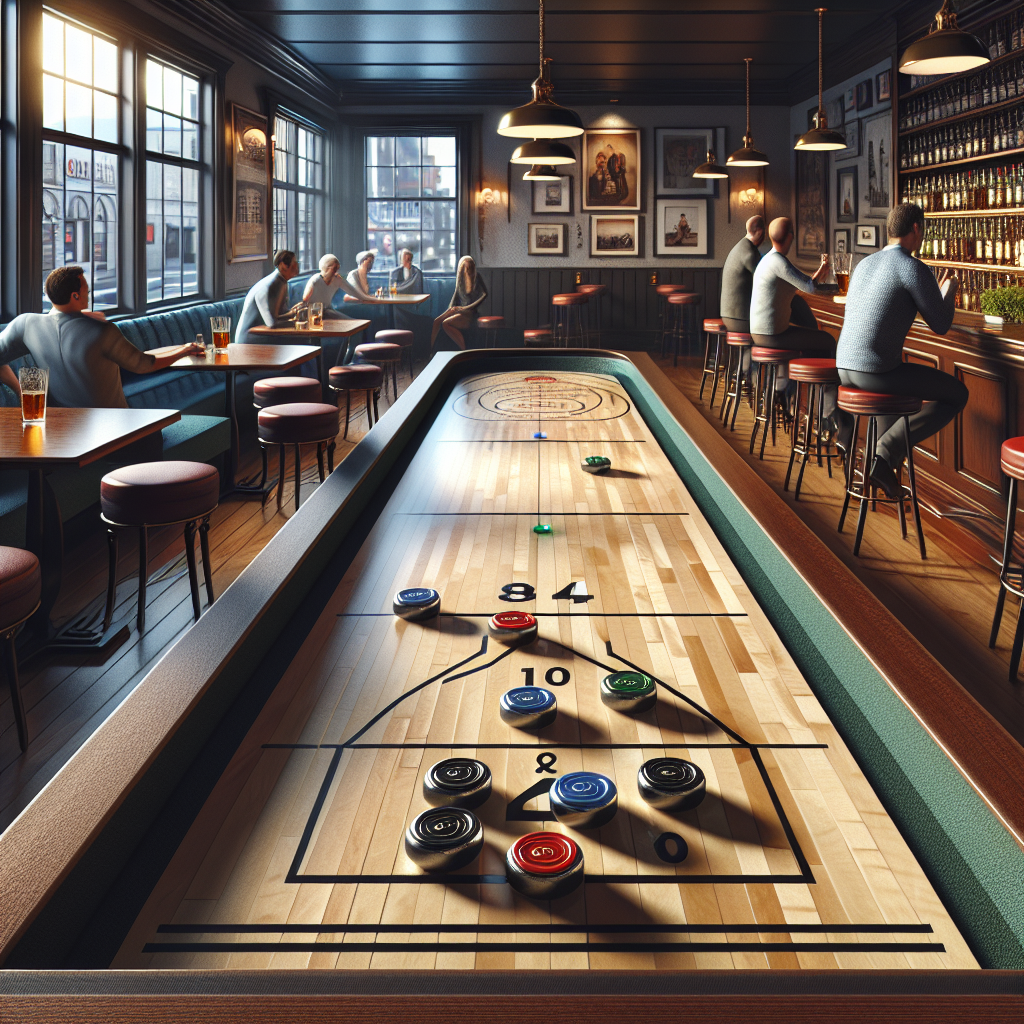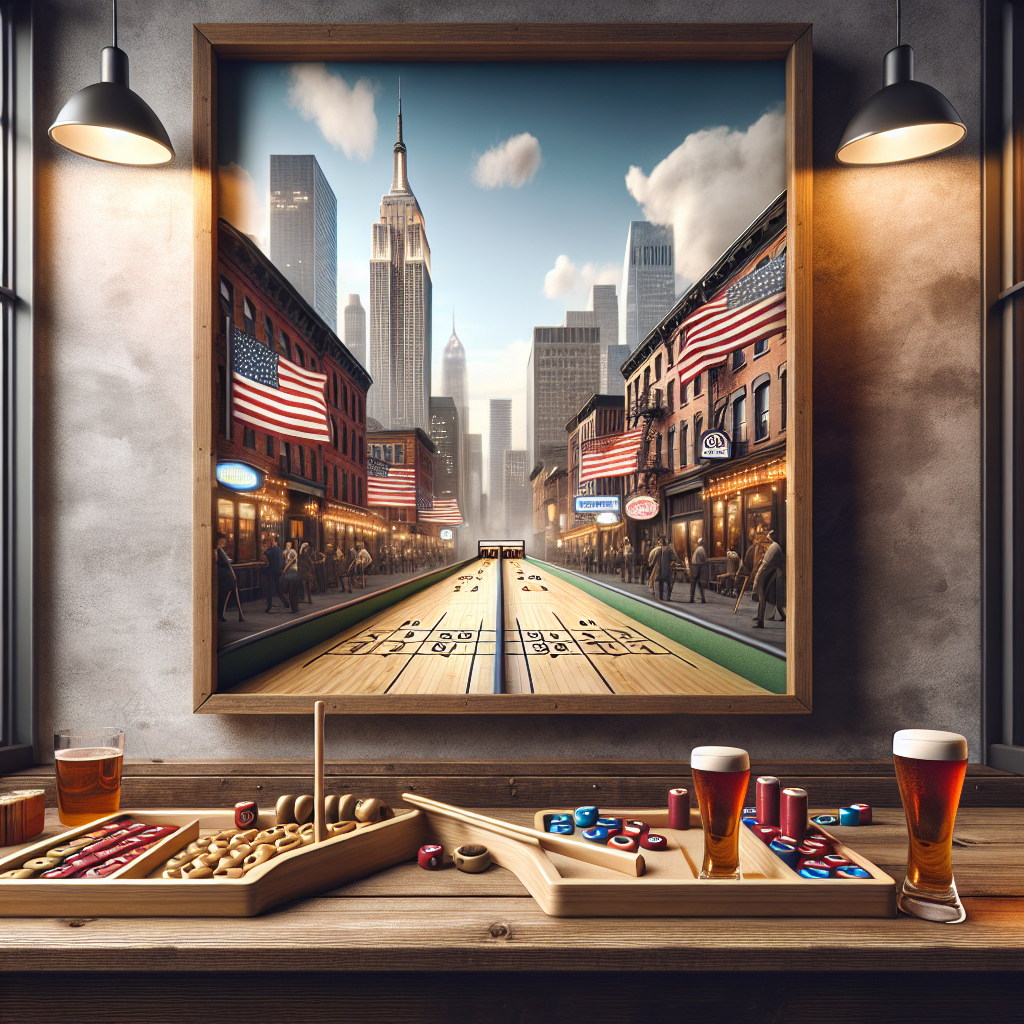Bar Shuffleboard Basics
In the world of bar games, bar shuffleboard has gained popularity for its combination of skill and strategy. This classic game, also known as table shuffleboard, involves players sliding weighted pucks down a long, smooth surface in an attempt to score points. Let’s explore the basics of bar shuffleboard and the appeal it holds for players.
Introduction to Bar Shuffleboard
Bar shuffleboard traces its origins back to the 15th century, where it was played on decks of ships. Over time, it evolved into a popular bar game, providing entertainment and friendly competition for adults. The game is typically played on a shuffleboard table that features a smooth playing surface, divided into distinct scoring areas. Players take turns sliding their pucks, aiming to land them within the scoring zones while strategically blocking their opponents’ pucks.
Bar shuffleboard offers a unique blend of skill, strategy, and precision. It requires players to assess the speed and angle of their shots, adjusting their technique to account for the surface and the position of their opponents’ pucks. The game can be enjoyed by players of all skill levels, making it a popular choice for social gatherings and bar environments.
The Appeal of Bar Shuffleboard
Bar shuffleboard has a wide appeal due to its engaging nature and the enjoyment it brings to players. Some of the key reasons why people are drawn to bar shuffleboard include:
-
Social Interaction: Shuffleboard is a social game that encourages friendly competition and interaction between players. It provides an opportunity to engage with friends, old and new, as players discuss strategies, celebrate successes, and share in the excitement of the game.
-
Skill Development: Bar shuffleboard requires players to develop and refine their skills in order to consistently place their pucks in scoring positions. This pursuit of skill improvement serves as a rewarding challenge for players, keeping them engaged and motivated to hone their techniques.
-
Accessible to All: Bar shuffleboard is a game that can be enjoyed by anyone, regardless of age or physical ability. The rules are relatively simple to grasp, and players can choose their level of competitiveness, making it an inclusive game that accommodates different skill levels.
-
Strategic Thinking: To excel in bar shuffleboard, players must think strategically, carefully considering shot placement and anticipating their opponents’ moves. This mental engagement adds an element of strategic thinking to the game, making it intellectually stimulating and satisfying for players.
With its rich history and engaging gameplay, bar shuffleboard continues to captivate players in bars and social settings around the world. Whether you’re a beginner or a seasoned player, the game offers a delightful combination of skill, strategy, and social interaction that keeps players coming back for more.
Bar Shuffleboard Dimensions
When it comes to bar shuffleboard, understanding the dimensions of the shuffleboard table is essential for a successful and enjoyable game. In this section, we will explore the regulation size shuffleboard tables, custom shuffleboard sizes, and the space requirements for bar shuffleboard.
Regulation Size Shuffleboard Tables
Regulation size shuffleboard tables are the standard for professional play and tournaments. These tables are typically 22 feet in length and 20 inches wide (Shuffleboard.net). It’s important to note that the actual dimensions of the table may be slightly larger due to the cradle, which adds inches to the length and width. Therefore, the actual size of a regulation shuffleboard table is approximately 23 feet long and 31 inches wide (Triangle Billiards).
Custom Shuffleboard Sizes
While regulation size shuffleboard tables are the standard, there are also custom shuffleboard sizes available to suit different spaces and preferences. Shuffleboard tables can range in size from 9 feet to 22 feet in length, with tables typically created in 2-foot increments starting at the 12-foot size (McClure Tables). The length and width of the shuffleboard table can impact the gameplay experience, so it’s important to consider the available space and personal preferences when choosing a custom size.
Here are some common shuffleboard table sizes:
| Shuffleboard Size | Length (feet) | Width (inches) |
|---|---|---|
| 7′ – 9′ | Varies | Varies |
| 12′ – 14′ | Varies | Varies |
| 16′ – 18′ | Varies | Varies |
| 22′ (Regulation Size) | 22 | 20 |
Table dimensions courtesy of Wayfair
Space Requirements for Bar Shuffleboard
When considering a bar shuffleboard table, it’s important to allocate enough space to accommodate the table and players comfortably. A regulation size shuffleboard table requires a room that is at least 26 feet long and 8 feet wide, including a free space of at least 2 feet around the table for players to maneuver (Triangle Billiards). However, if you opt for a smaller custom size, the space requirements will vary accordingly.
Before purchasing a shuffleboard table, it’s crucial to measure the available space where the table will be placed. This ensures that the table fits properly and allows players to play the game comfortably.
Understanding the dimensions of a shuffleboard table and the space requirements will help you make an informed decision when choosing the right shuffleboard table for your bar or recreational space. Whether you prefer a regulation size table or a custom size, having the appropriate dimensions will contribute to an enjoyable and successful game of bar shuffleboard.
Choosing the Right Shuffleboard Size
When it comes to selecting the right shuffleboard size for your bar, there are several factors to consider. The size of the shuffleboard table will impact the gameplay experience and the available space in your bar. Let’s explore the factors to consider, recommended shuffleboard sizes, and smaller shuffleboard options.
Factors to Consider
There are a few important factors to consider when choosing the right shuffleboard size for your bar:
-
Available Space: Measure the area where you plan to place the shuffleboard table to ensure it fits properly. Consider the length and width of the space, as well as any surrounding furniture or obstacles that may affect gameplay.
-
Player Skill Level: The skill level of the players can also influence the choice of shuffleboard size. Smaller tables may be suitable for beginners or casual players, while larger tables provide a more challenging experience for experienced players.
-
Budget: The cost of the shuffleboard table can vary based on its size. Consider your budget and determine the size that fits within your financial constraints.
Recommended Shuffleboard Sizes
Shuffleboard tables come in various sizes to accommodate different spaces and player preferences. Here are some recommended shuffleboard sizes:
| Table Size | Length (feet) | Suitable For |
|---|---|---|
| 9 feet | 9 | Home use and smaller spaces |
| 12 feet | 12 | Tournament size |
| 22 feet | 22 | Regulation size for professional play |
Table sizes ranging from 7 feet to 9 feet are suitable for smaller spaces and home use, providing an enjoyable shuffleboard experience for casual players. For those looking for a more competitive experience, the tournament-size 12-foot table is a popular choice. Professional players and tournaments typically use the regulation-size 22-foot table. The longer length allows for more challenging gameplay and accommodates multiple players on each side of the table.
Smaller Shuffleboard Options
If space is limited in your bar, there are smaller shuffleboard options available that can still provide an enjoyable playing experience. These smaller tables are suitable for practice, skill development, and smaller areas. While they may not offer the same level of challenge as the full-length tables, they are a great option for those who want to enjoy shuffleboard in a more compact space.
Remember to consider the dimensions of the shuffleboard table and choose the size that best suits your bar’s space constraints and the preferences of your patrons. Whether you opt for a regulation-size table or a smaller option, the key is to provide an engaging and enjoyable shuffleboard experience for your customers.
To learn more about the rules, scoring, and techniques of bar shuffleboard, be sure to check out our articles on bar shuffleboard rules, how to play bar shuffleboard, and bar shuffleboard scoring.
Shuffleboard Table Features
To fully understand bar shuffleboard, it’s important to explore the various features of shuffleboard tables. These features play a significant role in the gameplay experience and can affect the overall enjoyment of the game. In this section, we will delve into the playing surface materials, scoring systems, and portable shuffleboard tables.
Playing Surface Materials
The playing surface of a shuffleboard table is crucial for smooth sliding and consistent gameplay. It must be completely flat and seamless along the entire length and width. The most common materials used for the playing surface are solid wood and medium-density fiberboard (MDF) (Watson’s). MDF provides durability at an affordable price point, while solid wood adds an attractive aesthetic but requires extra maintenance to maintain a slick finish.
Most quality shuffleboard tables feature a polymer resin or smooth laminate playing field. These materials offer the right amount of glide and speed, ensuring a satisfying gameplay experience. The surface board thickness of shuffleboard tables typically ranges from 1.5 to 3 inches, with 3 inches being the most common measure. The surface board is slightly concave to prevent the puck from sliding off the edges.
To enhance the sliding action of the puck, shuffleboard wax, also known as shuffleboard sand or shuffleboard powder, is sprinkled on the table before the start of a game. Different types of wax are available, with slower waxes allowing for more friction and slower puck glide, while faster waxes are suitable for longer tables and professional play (Triangle Billiards).
Scoring Systems
Scoring is an integral part of bar shuffleboard, adding excitement and competition to the game. There are various scoring systems used in shuffleboard, including traditional and modern approaches. The most common scoring system is the “traditional” or “standard” scoring system, where players aim to score points by sliding their pucks into the scoring zones at the opposite end of the table.
In the traditional scoring system, the scoring zones are divided into numerical sections, with higher points awarded for pucks that land closer to the edge of the table. The scoring sections are typically numbered from 1 to 10, with the highest points awarded for pucks that reach the farthest edge.
Modern shuffleboard tables may feature electronic scoring systems that automatically keep track of the score, making it easier for players to focus on the game. These electronic scoring systems often come with LED displays that show the current score and other game-related information.
Portable Shuffleboard Tables
For those who want to enjoy bar shuffleboard outside of traditional bar settings, portable shuffleboard tables offer a convenient solution. These tables are designed to be lightweight and easily transportable, allowing you to set up a game of shuffleboard wherever you desire. Portable shuffleboard tables are ideal for social gatherings, parties, or even outdoor events.
Portable shuffleboard tables come in various sizes and designs, offering flexibility for different playing environments. They are typically made with materials that can withstand outdoor conditions, ensuring durability and longevity.
By considering the playing surface materials, scoring systems, and portable options, you can choose a shuffleboard table that suits your preferences and playing style. Whether you opt for a traditional wooden table or a modern portable option, these features will contribute to the overall enjoyment and success of your bar shuffleboard experience.
Playing Table Shuffleboard
Table shuffleboard is a popular game played in bars and recreational spaces. It requires skill, accuracy, and strategic thinking. In this section, we will explore the rules and scoring, techniques and strategies, and the differences between table shuffleboard and deck shuffleboard.
Rules and Scoring
To play table shuffleboard, players take turns sliding weighted discs down a long, smooth playing surface, aiming to land them in scoring zones and outscore their opponents. The game typically follows these basic rules:
-
Game Setup: Determine the order of play, usually by a coin toss. Each player or team stands at one end of the shuffleboard table.
-
Scoring Zones: Table shuffleboard has three different scoring zones, labeled as Zones 1, 2, and 3. These zones are divided by horizontal lines on the playing surface. The aim is to slide the discs into the furthest zone while trying to outscore opponents.
-
Scoring Points: The discs that land in different scoring zones earn varying points. The discs landing in Zone 1 score the lowest points, while those in Zone 3 score the highest. The exact point values may vary depending on the specific shuffleboard table being used.
-
Canceling Points: If both players or teams have discs in the same scoring zone, their points cancel each other out. Only the highest-scoring disc in each zone counts towards the overall score.
The specific rules and scoring system may vary slightly depending on the establishment or region. For more detailed information on the rules of bar shuffleboard, including tips on how to play, visit our article on bar shuffleboard rules.
Techniques and Strategies
Mastering table shuffleboard requires a combination of physical technique and strategic thinking. Here are some techniques and strategies that can enhance your gameplay:
-
Slide Technique: Develop a consistent and controlled slide technique. Proper foot positioning, balance, and a smooth release of the disc are essential for accurate shots.
-
Aiming: Practice aiming your shots to land the disc in the desired scoring zones. Adjust your aim and power based on the distance to the target zone.
-
Defensive Play: Strategize defensively by placing your discs strategically to block your opponent’s shots or limit their scoring opportunities.
-
Knocking Opponent’s Discs: Target your opponent’s discs to knock them out of scoring positions or into less favorable zones.
-
Weight Management: Master the weight of your shots. Adjust the force applied to the disc to control its speed and distance.
By honing these techniques and experimenting with different strategies, you can improve your performance and increase your chances of success on the shuffleboard table.
Differences from Deck Shuffleboard
Table shuffleboard differs from deck shuffleboard in several ways. In deck shuffleboard, the scoring zones are arranged in a triangle shape, with more scoring zones available (Shuffleboard.net). Additionally, deck shuffleboard has a zone called “10 off,” where discs that end up in this zone result in a deduction of 10 points from the player’s score. Players often strategize to knock their opponent’s discs into this zone to reduce their score (Shuffleboard.net).
While the basic concept of sliding discs towards scoring zones remains the same, the nuances between table shuffleboard and deck shuffleboard make each game unique. If you are interested in learning more about deck shuffleboard, be sure to check out our article on deck shuffleboard.
Understanding the rules, implementing effective techniques, and adapting strategies to the specific gameplay of table shuffleboard can greatly enhance your enjoyment and success in this exciting bar game.








